
Jan van Eyck stands as a colossus in the annals of art history, a pivotal figure whose work defines the apex of the Early Netherlandish school and marks a turning point in the Northern Renaissance. Active primarily in Bruges during the first half of the 15th century, his mastery of the oil medium, his breathtaking realism, and his profound attention to detail revolutionized painting in Northern Europe and left an indelible mark on generations of artists to come. Though shrouded in some mystery, his life and work offer a fascinating glimpse into the rich cultural milieu of the Burgundian Netherlands.
Origins and Early Career
The precise details of Jan van Eyck's birth remain elusive, a common challenge when studying figures from this period. Historical consensus places his birth sometime between 1385 and 1390, though some earlier sources suggested a date closer to 1380. Maaseik, a town in the Prince-Bishopric of Liège (modern-day Belgium), is generally accepted as his birthplace. Information about his early training is scarce, but it is widely believed he may have initially learned his craft alongside his older brother, Hubert van Eyck, who was also a painter of considerable skill, though fewer works can be definitively attributed to him.
Documentary evidence places Jan van Eyck in The Hague by 1422, where he served as court painter and valet de chambre to John III, the ruthless Duke of Bavaria-Straubing, Count of Holland and Hainaut. His position involved not only painting but also decorating the ducal palace, the Binnenhof. This early patronage indicates that his talents were already recognized at a high level. His time in The Hague likely provided him with valuable experience and exposure, setting the stage for his subsequent, more famous appointment.
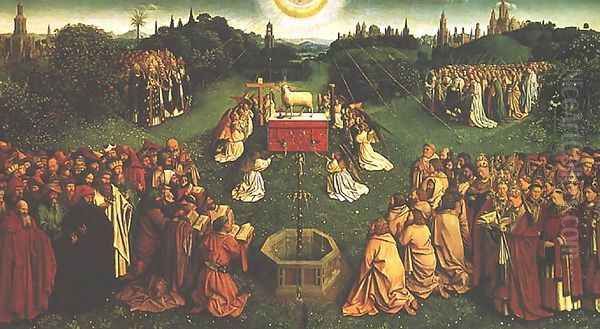
Following the death of John of Bavaria in 1425, Jan van Eyck quickly found new and even more prestigious employment. He entered the service of Philip the Good, the powerful and culturally sophisticated Duke of Burgundy. This move marked a significant step in his career, placing him at the heart of one of Europe's most vibrant and wealthy courts. Philip held Van Eyck in exceptionally high regard, not merely as a craftsman but as a valued courtier.
Court Painter and Diplomat for Burgundy
Under Philip the Good, Van Eyck settled in Bruges, which was then a thriving center of international commerce and finance, providing a fertile environment for artistic patronage. His official title remained valet de chambre, a position of trust that granted him unusual access to the Duke and a generous salary. Philip's appreciation for Van Eyck was evident; he even served as godfather to one of Van Eyck's children and intervened when the painter's salary payments were delayed by treasury officials, stating he could find no other artist of equal talent and "so much to his liking."
Beyond his artistic duties, Van Eyck undertook several confidential diplomatic missions for Duke Philip. These journeys exposed him to different regions and potentially different artistic influences. The most famous of these missions occurred in 1428-1429 when he traveled to Lisbon as part of an embassy seeking a marriage alliance between Philip and Isabella of Portugal. Van Eyck was tasked with painting two portraits of the princess so the Duke could see his potential bride. This diplomatic role underscores the high esteem in which he was held and his multifaceted role within the Burgundian court.
These travels, combined with the international character of Bruges, likely broadened Van Eyck's horizons. While his core style remained distinctly Netherlandish, his awareness of the world beyond Flanders undoubtedly enriched his understanding of representation and possibly exposed him to artistic developments elsewhere, even if direct Italian influence is debated among scholars. His position provided him security and the freedom to develop his unique artistic vision.
The Revolution in Oil Painting
Jan van Eyck is often popularly, though inaccurately, credited with "inventing" oil painting. While painting with oil-based binders existed before his time, Van Eyck perfected and revolutionized the technique to such a degree that he fundamentally changed the potential of the medium. Before him, tempera (pigment mixed with egg yolk) was the dominant medium for panel painting, known for its quick drying time and matte finish, which made subtle blending difficult.
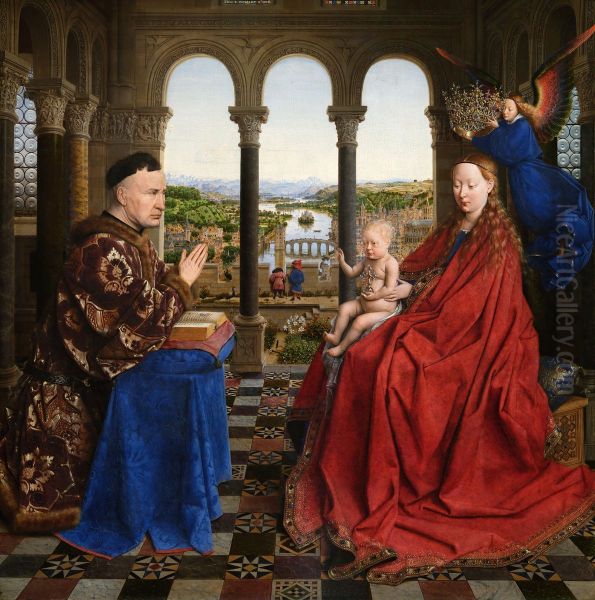
Van Eyck's innovation lay in his sophisticated use of oil, likely linseed or walnut oil, as a binder for finely ground pigments. He applied paint in multiple thin, translucent layers, known as glazes, over a smooth, reflective white gesso ground. This meticulous layering technique allowed light to penetrate the paint layers and reflect off the ground, creating unprecedented effects of luminosity, deep, saturated color, and subtle tonal gradations.
This mastery of oil glazing enabled Van Eyck to achieve a level of realism previously unseen. He could render the textures of fabrics like velvet and fur, the gleam of metal, the sparkle of jewels, and the soft translucency of human skin with astonishing verisimilitude. His technique allowed for slow, deliberate work, enabling the painstaking detail that characterizes his style. This technical prowess became a hallmark of Netherlandish painting, influencing artists across Europe, including figures like Antonello da Messina in Italy, who was fascinated by the possibilities of the oil medium.
Hallmarks of Van Eyck's Style: Realism and Detail
The most striking feature of Jan van Eyck's art is its intense realism, often described as microscopic-telescopic. He rendered the world with an unwavering commitment to empirical observation. Every detail, from the intricate patterns in a carpet to the reflection in a polished surface, is captured with meticulous precision. This was not merely photographic reproduction; it was a carefully constructed reality, imbued with a sense of heightened presence.
His depiction of light is central to his realism. He masterfully captured the way light falls on different surfaces, defining form, creating atmosphere, and unifying the composition. Whether depicting the soft glow filtering through a window or the sharp glint on armor, his handling of light and shadow (chiaroscuro) lends his scenes a palpable sense of space and volume. He also employed atmospheric perspective, subtly altering color and detail in distant landscape elements to create a convincing illusion of depth.
Texture was another area of Van Eyck's expertise. His paintings are a feast for the eyes, inviting the viewer to almost feel the softness of fur, the richness of brocade, the coolness of stone, or the warmth of wood grain. This tactile quality further enhances the illusion of reality. His portraits are equally remarkable for their psychological penetration, capturing not just the physical likeness but also a sense of the sitter's inner life and social standing, often through subtle details of expression and pose.
Masterworks: The Ghent Altarpiece
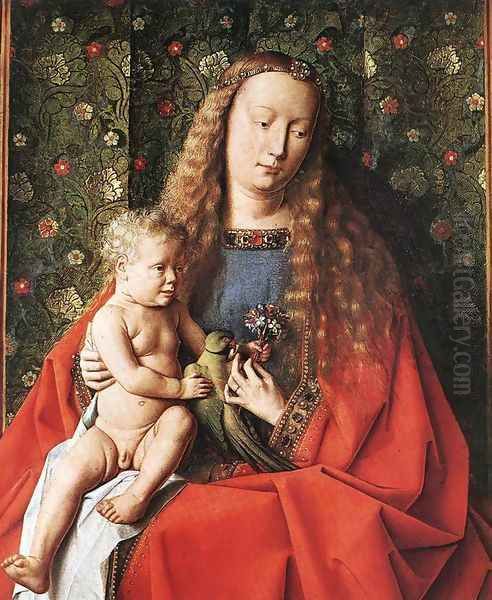
Perhaps Jan van Eyck's most famous and complex work is the Adoration of the Mystic Lamb, commonly known as the Ghent Altarpiece. Completed and installed in Saint Bavo Cathedral in Ghent in 1432, this monumental polyptych is a cornerstone of Western art. An inscription, discovered in the 19th century but whose authenticity is debated, suggests the work was begun by Hubert van Eyck ("greater than whom no one was found") and completed by Jan ("second in art"). Regardless of the precise division of labor, the altarpiece stands as a testament to the Eyckian vision.
When closed, the altarpiece displays figures painted in grisaille (shades of grey) simulating sculpture, depicting the Annunciation, prophets, sibyls, and the donors, Joos Vijd and Elisabeth Borluut. When opened, it reveals a dazzling spectacle of color and detail across twelve panels. The upper register features God the Father (or Christ the King) enthroned, flanked by the Virgin Mary and John the Baptist, choirs of angels, and Adam and Eve.
The lower central panel, the Adoration of the Mystic Lamb, is the heart of the altarpiece. It depicts a lush landscape where saints, prophets, martyrs, and pilgrims converge from all corners to worship the Lamb of God, symbolizing Christ's sacrifice, upon an altar. The scene is rendered with breathtaking detail, from the individual species of plants in the meadow to the jeweled vestments of the figures. The Ghent Altarpiece encapsulates Van Eyck's technical brilliance, his profound religious conviction, and his ability to synthesize complex theological ideas into a visually stunning and coherent whole. It influenced countless artists, including Hugo van der Goes, whose own Portinari Altarpiece shows its impact.
Masterworks: The Arnolfini Portrait
Equally iconic, though vastly different in scale and subject, is the Arnolfini Portrait (or Arnolfini Wedding) dated 1434 and now housed in the National Gallery, London. This captivating double portrait depicts the wealthy Italian merchant Giovanni di Nicolao Arnolfini and his wife, possibly Giovanna Cenami, standing in a richly furnished interior. The painting is renowned for its intricate detail, complex symbolism, and masterful handling of light and texture.
Every element seems meticulously chosen and rendered: the luxurious fabrics of their clothing, the brass chandelier, the convex mirror on the back wall, the discarded pattens, the small dog (a symbol of fidelity), and the single lit candle in the chandelier (often interpreted as the all-seeing eye of God or a nuptial candle). The mirror is a technical marvel, reflecting the back view of the couple, two other figures in the doorway (one perhaps the artist himself), and the room's architecture in miniature.
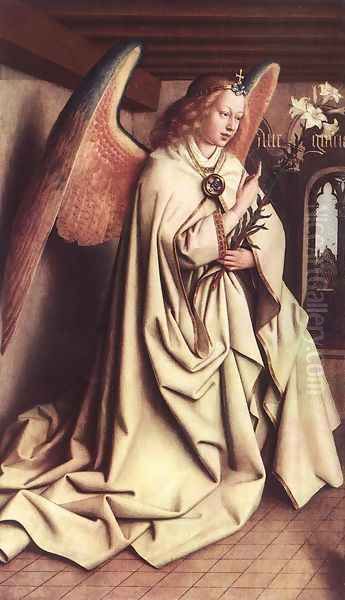
Above the mirror, Van Eyck inscribed "Johannes de eyck fuit hic. 1434" ("Jan van Eyck was here. 1434"). This unusual signature has fueled debate about the painting's purpose – is it a wedding certificate, a betrothal record, a memorial portrait, or a testament to Arnolfini's wealth and piety? Regardless of its precise meaning, the Arnolfini Portrait remains a landmark of portraiture and genre painting, showcasing Van Eyck's unparalleled skill in capturing both the material world and an enigmatic human presence. Its influence can be seen in later detailed interior scenes by artists like Vermeer.
Other Notable Works
Beyond these two towering achievements, Van Eyck produced a significant body of work, primarily portraits and religious scenes, often commissioned by wealthy patrons like Chancellor Rolin or Canon van der Paele.
The Madonna of Chancellor Rolin (c. 1435) depicts the powerful chancellor of Burgundy kneeling in prayer before the Virgin and Child. The scene is set within an elaborate loggia opening onto a minutely detailed landscape featuring a river, city, and distant mountains. The work masterfully contrasts the spiritual encounter with the tangible reality of the figures and their opulent surroundings.
Similarly, the Madonna with Canon van der Paele (1436) shows the aged canon being presented to the Virgin and Child by Saint George (his name saint) and Saint Donatian (the patron saint of Bruges Cathedral, where the painting was originally housed). The work is remarkable for its realistic portrayal of the aging canon and the incredibly detailed rendering of Saint George's reflective armor and the rich textiles.
Van Eyck also produced smaller, intense portraits. The Portrait of a Man (Self Portrait?) (1433), often speculated to be a self-image due to the direct gaze and the inscription "Als ich kan" ("As I can" or "As best I can") on the frame, is a compelling study of individuality. The Portrait of Margaret van Eyck (1439), depicting his wife, offers a more intimate glimpse, rendered with characteristic honesty and precision. The small Saint Francis Receiving the Stigmata (c. 1430-32) demonstrates his ability to convey intense religious experience within a detailed natural setting.
Symbolism and Iconography
Van Eyck's paintings are rarely just depictions of the visible world; they are often layered with complex symbolism and religious meaning, a practice common in the period known as disguised symbolism. Objects that appear naturalistic often carry deeper theological or moral significance.
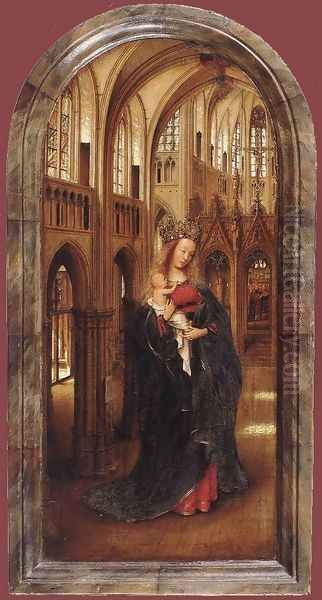
In the Arnolfini Portrait, interpretations abound: the dog symbolizes marital fidelity, the discarded shoes suggest holy ground or domesticity, the fruit on the windowsill might represent fertility or the Fall of Man, the single candle could signify God's presence or the flame of love. In religious works like the Madonna of Chancellor Rolin, the detailed cityscape might represent the earthly realm contrasted with the heavenly figures, while specific flowers or architectural details could carry Marian symbolism.
Understanding this iconography requires knowledge of 15th-century religious beliefs, social customs, and visual conventions. While some symbols are widely recognized (like the lily for Mary's purity), others remain debated by art historians. This intricate web of meaning adds another layer of richness to Van Eyck's work, inviting contemplation beyond the surface realism. His ability to seamlessly integrate profound symbolism within meticulously observed reality is a key aspect of his genius, distinguishing his work from the more straightforward narrative approach of some Italian contemporaries like Masaccio or Fra Angelico.
Van Eyck and His Contemporaries
Jan van Eyck was not working in isolation. He was part of a vibrant generation of Netherlandish painters who were transforming art in the North. His most significant contemporaries included Robert Campin (often identified as the Master of Flémalle) and Rogier van der Weyden. Campin, active primarily in Tournai, shared Van Eyck's interest in detailed realism but often with a more robust, sculptural quality to his figures.
Rogier van der Weyden, who became the official painter of Brussels, was profoundly influenced by Van Eyck's technical mastery and realism, yet developed a distinct style characterized by greater emotional intensity, dynamic compositions, and elegant, linear rhythms. While Van Eyck's figures often possess a calm, almost detached presence, Van der Weyden excelled at depicting pathos and dramatic tension, as seen in his famous Descent from the Cross.
Other important figures in this milieu included Petrus Christus, who worked in Bruges after Van Eyck's death and is sometimes considered his successor, though with a simpler, more geometric style. Dieric Bouts, active in Leuven, combined influences from both Van Eyck and Van der Weyden. Compared to the developments in Italy, where artists like Donatello and Brunelleschi were exploring classical forms and linear perspective, Van Eyck and his Northern peers forged a different path, prioritizing empirical observation, light effects, and textural detail.
The Workshop and Legacy
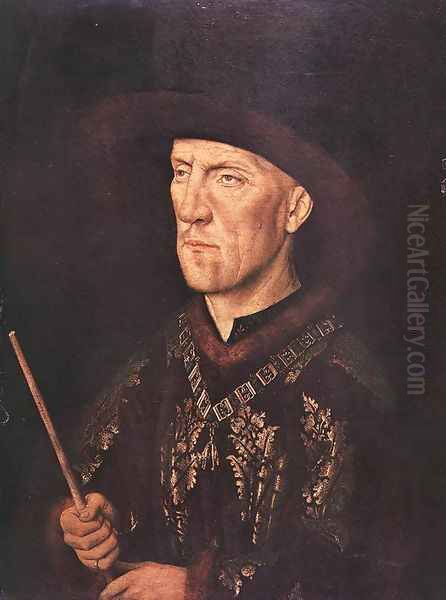
Like most successful artists of his time, Jan van Eyck likely maintained a workshop in Bruges to assist him with commissions, preparing panels, grinding pigments, and possibly painting less critical areas of larger works. The extent and nature of his workshop collaboration remain subjects of scholarly discussion. The aforementioned Petrus Christus is the artist most often linked to Van Eyck's immediate circle, potentially having spent time in his workshop towards the end of Van Eyck's life or shortly after his death.
Van Eyck's influence was immediate and far-reaching. His technical innovations in oil painting became the standard throughout Northern Europe for centuries. His detailed realism and complex iconography inspired generations of Netherlandish artists, including Hans Memling, who became the leading painter in Bruges after Christus, and later masters like Gerard David.
His fame spread beyond the Netherlands. His works were admired and collected in Italy, influencing artists there. German artists, most notably Albrecht Dürer, studied his work intently during travels to the Low Countries, absorbing aspects of his technique and meticulous observation. Even later Northern masters like Hans Holbein the Younger owe a debt to the Eyckian tradition of precise portraiture. Van Eyck laid the foundation upon which much of Northern European painting was built.
Later Reception and Art Historical Significance
While highly esteemed by patrons like Philip the Good during his lifetime, Van Eyck's broader critical reputation evolved over the centuries. Early Italian writers like Bartolomeo Fazio in the mid-15th century praised his work, particularly his realism and handling of light. The influential 16th-century biographer Giorgio Vasari, though primarily focused on Italian art, acknowledged Van Eyck's importance, albeit perpetuating the myth that he invented oil painting.
His reputation perhaps waned slightly in subsequent centuries but saw a major resurgence in the 19th century with the rise of art history as a discipline and a renewed appreciation for Northern European art. Critics and historians began to fully recognize the revolutionary nature of his technique and vision. He was hailed as a founder of the Netherlandish school and a key figure in the Northern Renaissance, a counterpart to the masters emerging in Florence.
Today, Jan van Eyck's status is undisputed. He is celebrated as one of the most significant painters in Western art history. His works are prized for their technical perfection, their stunning realism, their intricate symbolism, and their profound beauty. He is seen not just as a master craftsman but as an intellectual artist who fundamentally changed the way reality could be represented in paint, bridging the gap between the late Gothic world and the emerging modern era.
Unanswered Questions and Enduring Mystique

Despite extensive research, aspects of Jan van Eyck's life and work remain enigmatic. The precise date and circumstances of his birth, the full extent of his brother Hubert's contribution to the Ghent Altarpiece, the exact meanings embedded within the Arnolfini Portrait, and the details of his workshop practices are still debated by scholars. His cause of death on July 9, 1441, in Bruges is not recorded, though illness or complications from his travels are possibilities.
His personal motto, "Als ich kan" ("As I can" or "As best I can"), often inscribed on the frames of his paintings, adds to his mystique. It can be interpreted as a statement of humility, a declaration of his utmost effort, or even a subtle challenge. This phrase, like his penetrating gaze in the presumed self-portrait, hints at a complex, self-aware individual behind the meticulously crafted surfaces of his art.
These lingering questions do not diminish his stature; rather, they contribute to the enduring fascination surrounding Jan van Eyck. His paintings continue to captivate viewers with their blend of astonishing realism and profound mystery, inviting endless looking and interpretation.
Conclusion
Jan van Eyck was more than just a painter; he was a visionary who redefined the possibilities of his medium and the representation of the world. Through his unparalleled mastery of oil paint, his keen observation, and his intellectual depth, he created works that continue to resonate centuries later. From the monumental grandeur of the Ghent Altarpiece to the intimate enigma of the Arnolfini Portrait, his art embodies the spirit of the Northern Renaissance. As court painter, diplomat, technical innovator, and master of realism, Jan van Eyck secured his place as one of the foundational figures of Western art, leaving a legacy that profoundly shaped the course of painting in Europe.